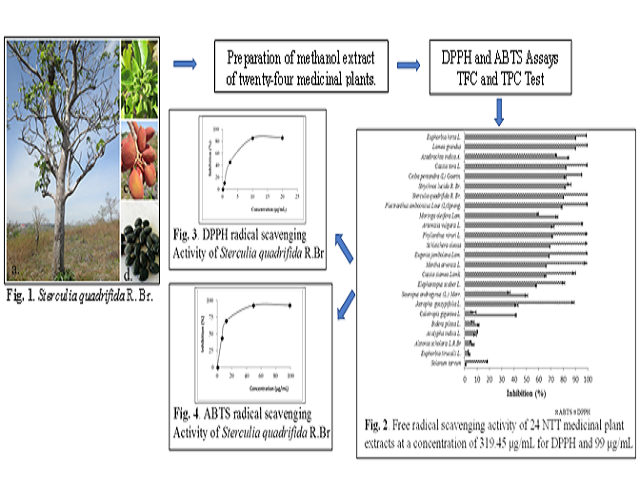Antioxidant Capacity of Some Selected Medicinal Plants in East Nusa Tenggara, Indonesia: The Potential of Sterculia quadrifida R.Br.
DOI:
https://doi.org/10.5530/fra.2018.2.15Keywords:
ABTS, Antioxidants, DPPH, Free radicals, Traditional medicinesAbstract
Background: Medicinal plants derived natural product such as alkaloids, flavonoids and terpenes. The traditional uses claim that medicinal plants of NTT are potential folk medicine but very little research has been conducted on these plants. Objective: The present study is directed towards evaluating naturally effective antioxidant of twenty-four traditional medicinal plants collected from Kupang, East Nusa Tenggara (NTT) using in vitro models. Method: The antioxidant activities were determined by using the free radical scavenging assays 1,1-diphenyl-2-picrylhydrazyl (DPPH) and 2-2”-azino-bis(3-ethylbenzothiazoline-6-sulfonic acid) (ABTS). Analysis of total flavonoid and phenolic contents were expressed as Quercetin Equivalent (QE) and Gallic Acid Equivalent (GAE), respectively. Statistical methods are used in data analysis include mean or standard deviation, and regression analysis. Result: Methanol extract of Sterculia quadrifida R. Br. root exhibited the highest DPPH radical scavenging activity with IC50 value of 3.11μg/mL, followed by Schleichera oleosa and Euphorbia hirta L. extracts with IC50 values of 10.05 and 10.09 μg/mL, respectively. Methanol extract of S. quadrifida also showed highest ABTS radical scavenging activity with IC50 value of 7.29 μg/mL, followed by Eugenia jambolana Lam. and Lamea grandus with IC50 value of 9.15 and 12.29 μg/mL, respectively. S. quadrifida extract showed high flavonoid and phenolic content with 661.85 mg of GAE and 116.84 mg of QE per 100 g of extracts. Conclusion: The present study gives scientific evidences that twenty four samples of NTT plants have high free radical scavenging capacity. Strong radical scavenging activity of these plants especially S. quadrifida could be considered as a potential source of natural antioxidants.
Downloads
Metrics





